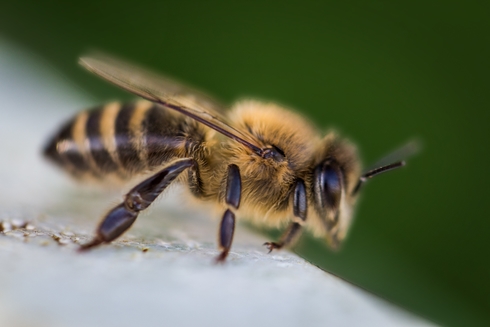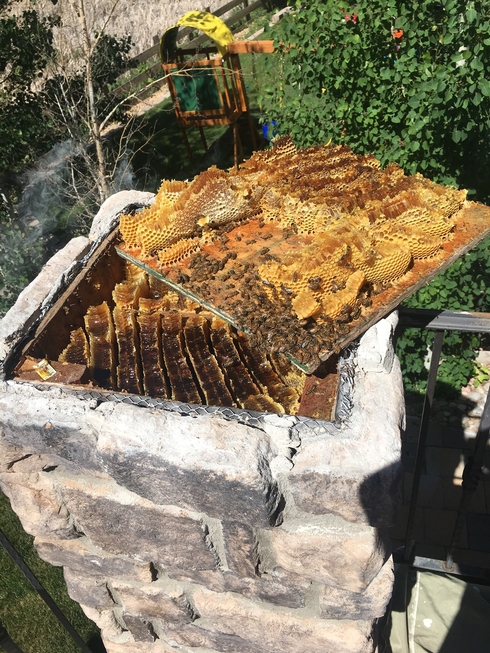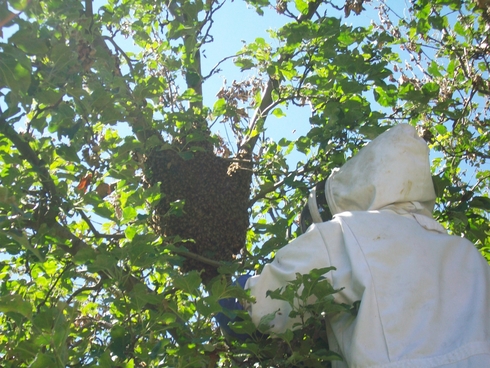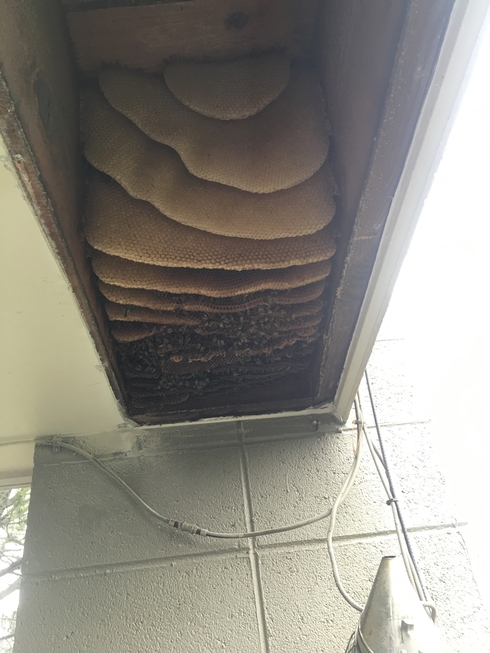Pest Control Service
Honey Bee Removal and Identification

Honey Bee Removal, Relocation and Structural Repairs
Bee Hive Removal Service
Due to the dense population and productivity of an established hive, there is no “simple” way to remove a honey bee colony from a structure’s interior. Despite a lot of misinformation and confusion between a swarm and a hive, bees can’t simply be “smoked” out of their hive. Smoking bees is simply a method of calming aggressive bees by clouding the pheromones they use to communicate with each other. Once a swarm moves into a location they’ll rapidly build honey comb and the queen will begin laying eggs as soon as comb is established. After they have comb and brood established there is not a lot that can be done to coerce them from their new home. Attempting to simply seal their point of entry is a common and often unfortunate mistake. At any given time of the day there will be thousands of bees out foraging, but there will also remain tens of thousands of bees inside the hive maintaining the colony’s integrity. By sealing their entry, you force the bees inside to search the structure’s interior for an alternative exit, which can ultimately lead to bees finding their way inside the living space of your home by the thousands. If you have bees entering a point on your home the best thing you can do is to leave them alone. By calling us and allowing us to better understand your situation we can provide you with the best options available to properly and safely remove the hive.
Honey bees typically have a relatively calm disposition and aren’t easily provoked. They arrive to a location as a swarm early in the year and prefer to establish their colonies in enclosed, contained cavities that they can protect and seal from predators and weather. A swarm will arrive with a queen and up to 15,000 workers bees that have split from an established hive nearby. A mature hive can maintain a population of anywhere from 30,000 to 60,000 bees depending on the time of year. Over a single season, a colony of honey bees can create a wax hive that can contain over a hundred pounds of honeycomb. In residential homes we commonly find honey bees prone to locations such as soffits and eaves, floor joists, deck columns, chimneys and porch roofs. They don’t typically infest open attic spaces, crawl spaces or exterior insulated walls, although it does happen occasionally. We specialize in the necessary trades to effectively locate a hive, enter a structure’s interior, remove a hive for relocation and reassemble and seal the structure to ensure there is no damage and no potential risk of a future infestation. Our dedication is to maintain the integrity and aesthetic of your home while giving the bees the ability to be transplanted safely to one of the many beekeepers we work with throughout the state. Our honey bee removal service comes with a one year warranty against any new infestation as well as our word that we’ll treat your home as if it were our own.
Honey bees are essential to our planet as well as our way of life. We can thank honey bees for providing us with most of the fruits and vegetables that are available to us. They are extraordinary pollinators. However, their survival is at stake and their populations have been declining at an alarming rate for over two decades. A condition generally referred to as “colony collapse disorder” is afflicting honey bees around the world. Honey bees are protected by the EPA and considered an endangered species. It is for these reasons as well as several others that we practice only humane removal and relocation services when we encounter a honey bee colony or swarm. Honey bee hives are very dense and will completely fill the void they’re built in. Most chemicals can’t penetrate through a hive to reach the entire colony. Even if the entire population of bees is eradicated, the issue then becomes the massive hive and all the brood that remains inside the structure. Not only will this rot and become extremely foul but all the honey will run out of the comb and make a far bigger mess than if properly removed. The remaining hive and honey can eventually attract mice, ants, squirrels and potentially another honey bee swarm that will move in and reestablish a new hive, utilizing any old honey comb left intact.
Honey Bees “Swarm”
Honey bees “swarm” in the spring and early summer months in order to establish new hives and continue their species’ population. A mature hive is perennial, they don’t hibernate or go dormant during winter. Honey bees continue to maintain the same established hive year after year. A healthy hive will have one queen but will produce several sister queens in the spring that leave the hive with thousands of other worker bees. Swarms can travel several miles a day in search of a new location to colonize. Often, swarms will congregate together in trees or on fences temporarily while they rest, sometimes overnight. Because they have no hive or brood to protect, a swarm of honey bees is typically very docile. Discovering a swarm in person can be daunting, but the best thing you can do is leave them alone. They will typically leave within a few hours or in the instance of cold weather, within a day or two. We typically try not to capture honey bee swarms as it is in their nature and best interests to establish new hives. If it is necessary to capture a swarm, we can relocate them to an apiary where they can establish a new hive in a welcomed, safe environment.

Honey Bee Removal



Bee Identification
Honey bees are fuzzy, light brown or amber insects with black stripes on their abdomen. They will usually colonize inside an enclosed structure so you won’t see a hive. All someone will see is their foraging traffic to and from the hive entry during the warm hours of the day. Honey bees produce massive beeswax hives weighing up to 100 lbs or more in one season. A healthy hive can thrive for a decade or more if given the right conditions. Honey bees are incredibly beneficial and it is imperative we do everything we can to remove and relocate them in a humane manner.
Bee Removal
-
#1 Bee Removal Services in Denver
-
Top Rated Bee Removal
-
We safely and humanely relocate your bees
-
Bee Hive Removal Services in the Denver Metro Area